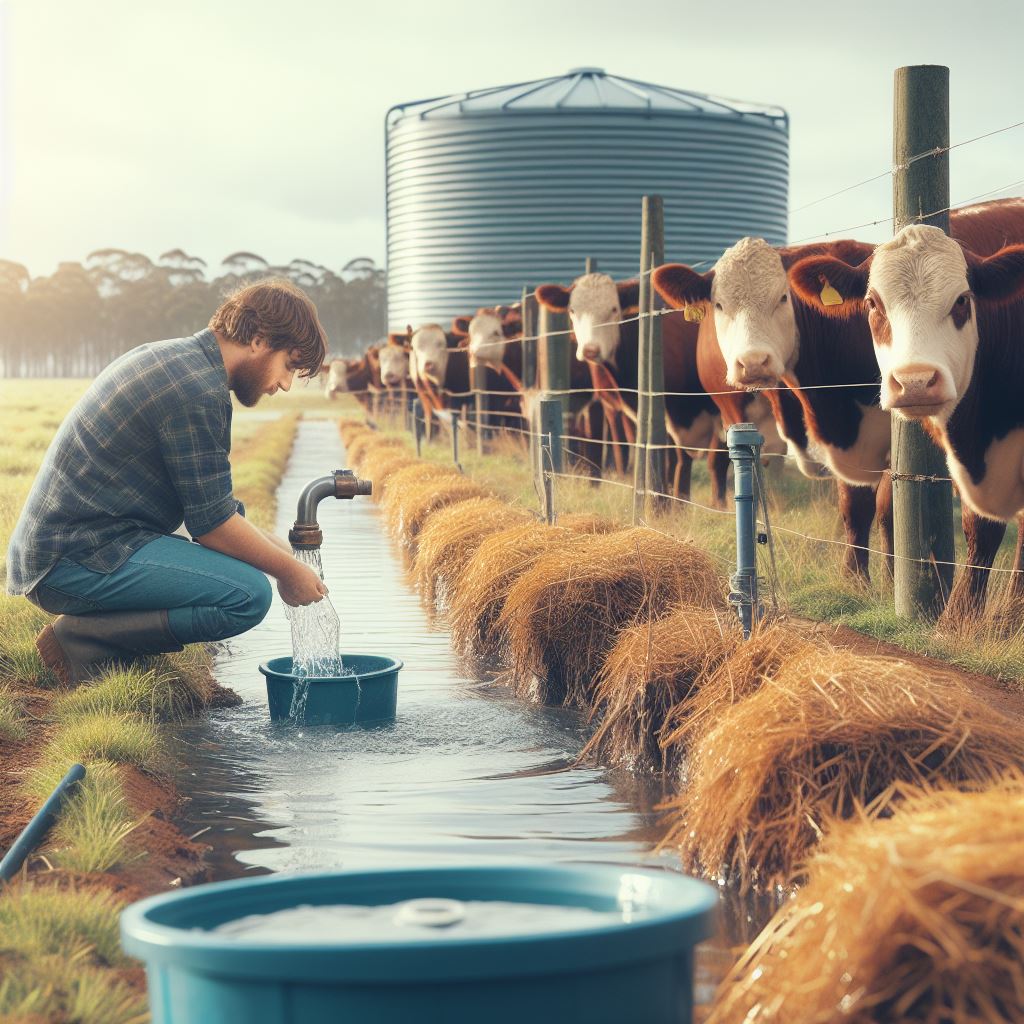Introduction
Importance of maximizing grass growth in pastures
Healthy and abundant grass growth in pastures is vital for maintaining livestock nutrition and promoting a sustainable ecosystem.
By implementing effective strategies, farmers and ranchers can ensure the availability of nutrient-rich grass for their animals, minimize the need for additional feed supplementation, and improve overall pasture quality.
Overview of the blog post
This blog post aims to discuss the importance of maximizing grass growth in pastures and provide insights into practical methods that can be employed to achieve this objective.
By exploring various techniques, readers will gain valuable knowledge on how they can optimize their grazing management practices to maximize productivity.
Several factors contribute to successful grass growth, such as proper soil management, timely fertilization, and strategic stocking rates.
Understanding these factors and implementing appropriate measures can significantly enhance pasture health and productivity.
Additionally, this blog post will highlight the benefits of maximizing grass growth in pastures.
Besides addressing livestock nutritional requirements, optimal grass growth supports soil conservation, water infiltration, carbon sequestration, and biodiversity.
Enhanced grass growth also leads to higher carrying capacities and potential economic returns for the farmers.
Therefore, this blog post offers readers an opportunity to explore the significance of maximizing grass growth in pastures and gain valuable insights into effective strategies for achieving this goal.
By implementing these strategies, farmers and ranchers can ensure a sustainable and productive agricultural system while contributing to environmental conservation.
Understanding the Basics of Grass Growth
Factors influencing grass growth in pastures
- Soil fertility and pH levels: Nutrient-rich soil and balanced pH levels are crucial for optimal grass growth.
- Climate and weather conditions: Adequate rainfall, temperature, and sunlight play vital roles in grass growth.
- Species and varieties of grasses: Different types of grasses have varying growth requirements and characteristics.
The role of sunlight and photosynthesis
Sunlight is pivotal for grass growth as it fuels photosynthesis, converting light energy into chemical energy for thriving.
- Sunlight initiates photosynthesis, absorbed by grass blades through chloroplasts housing chlorophyll, providing the green pigment.
- Chlorophyll transforms light energy into glucose, fueling cellular processes and growth while releasing oxygen into the atmosphere.
A pasture’s grass growth is directly linked to sunlight availability, impacted by obstacles creating shaded areas.
To enhance grass growth, optimize sunlight exposure by:
- Pruning or removing shading trees and large shrubs.
- Trimming nearby vegetation to prevent overshadowing.
- Rotating livestock grazing for even impact distribution and shaded area recovery.
- Implementing pasture management practices, including fertilization, watering, and soil testing.
- Choosing suitable grass species for local climate and soil conditions, ensuring maximum growth potential.
Understanding these basics empowers pasture owners to make informed decisions for thriving pastures.
Transform Your Agribusiness
Unlock your farm's potential with expert advice tailored to your needs. Get actionable steps that drive real results.
Get StartedRemember, optimizing sunlight is crucial for healthy and vibrant grasslands.
Read: Balancing Pasture Nutrition Needs
Soil Management Techniques for Maximizing Grass Growth
Conducting soil tests for nutrient analysis
- Regular soil testing is essential for determining the nutrient levels in the soil.
- Soil tests help identify any nutrient deficiencies or excesses that may hinder grass growth.
- The results of soil tests provide valuable information for appropriate fertilizer application.
- A professional soil testing service can accurately analyze the nutrient composition of the soil.
Adjusting soil pH levels through liming or acidification
- Grass growth can be affected by acidic or alkaline pH levels in the soil.
- Liming is necessary to raise the pH if soil is too acidic for optimal grass growth.
- Acidification with sulfur may be required if the soil pH is too alkaline.
- Regular monitoring and adjusting of soil pH levels improve nutrient availability and grass health.
Applying proper organic or synthetic fertilizers
- Fertilizers supply essential nutrients to the soil, promoting healthy grass growth.
- Organic fertilizers, such as compost or manure, improve soil structure and nutrient content.
- Synthetic fertilizers provide a quick release of nutrients, but may require precise application.
- Understanding the nutrient requirements of the grass species is crucial for effective fertilizer application.
Implementing erosion control measures
- Erosion can lead to the loss of topsoil and reduce grass growth in pastures.
- Planting cover crops or grasses with deep root systems help stabilize soil and prevent erosion.
- Installing terraces, contour plowing, or grassed waterways can control water runoff and prevent soil erosion.
- Proper pasture management techniques, such as rotational grazing, also minimize soil erosion.
Most importantly, maximizing grass growth in pastures requires proper soil management techniques.
Conducting soil tests, adjusting pH levels, applying fertilizers, and implementing erosion control measures are crucial steps to ensure optimal grass health and growth.
By understanding the specific needs of the soil and grass species, farmers can create an environment conducive to maximizing grass growth and improving pasture productivity.
Read: Egg Production: Boosting Quality & Quantity
Proper Grazing Management Practices
Achieving maximum grass growth in pastures requires implementing proper grazing management practices.
These practices contribute to the overall health and productivity of the pasture ecosystem.
Rotational grazing to prevent overgrazing
Rotational grazing involves dividing a pasture into smaller paddocks and rotating livestock among them.
This practice prevents overgrazing by giving the grass time to recover and regrow.
- This method ensures that animals only graze a portion of the pasture at a time.
- It allows the grass to rest and promotes even regrowth across the entire pasture.
- Rotational grazing also helps control weed growth and improves soil conservation.
Allowing for adequate rest and recovery periods for grass
In addition to rotational grazing, providing sufficient rest and recovery periods is crucial for maximizing grass growth in pastures.
- Grass needs time to recover and rebuild carbohydrates after being grazed.
- By allowing for adequate rest periods, grass has a chance to replenish its nutrient reserves and develop a strong root system.
- Regular monitoring of grass growth is essential to determine the appropriate length of rest periods.
Adjusting stocking density based on grass growth rates
To ensure optimal grass growth, stocking density should be adjusted according to the rate of grass growth.
- During periods of faster grass growth, more livestock can be introduced to utilize the available forage.
- Conversely, reducing stocking density during slower growth periods prevents overgrazing and allows grass to recover.
- Regular monitoring of grass growth rates and livestock numbers is necessary to make informed stocking density adjustments.
Utilizing temporary fencing for controlled grazing
Temporary fencing can be utilized to control grazing patterns and promote maximum grass growth.
- Dividing larger grazing areas into smaller sections using temporary fencing allows for controlled grazing.
- This prevents selective grazing and ensures even utilization of pasture resources.
- Temporary fencing can also be used to restrict access to specific areas that require special attention or rest.
In essence, implementing proper grazing management practices is essential for maximizing grass growth in pastures.
Rotational grazing, adequate rest periods, adjusting stocking density, and utilizing temporary fencing all contribute to the overall health and productivity of the pasture ecosystem.
By carefully managing these factors, farmers and ranchers can achieve optimal grass growth and maintain sustainable pasture management practices.
Read: Winter Care Tips for Your Poultry Flock

Irrigation and Water Management
Assessing water requirements based on grass species
- Identify the specific grass species in your pastures to determine their water needs.
- Different grasses have varying requirements, so understanding these will help maximize growth.
- Research each grass species to understand their preferred soil moisture levels and watering frequency.
- Consider factors such as temperature, rainfall patterns, and soil type to accurately assess water requirements.
- Consult with agricultural experts or extension services for guidance on specific grass species.
Proper irrigation techniques and efficient water usage
- Install an irrigation system that can efficiently deliver water to your pastures.
- Drip irrigation and sprinkler systems are commonly used methods for pastures.
- Regularly monitor soil moisture levels to ensure proper irrigation scheduling.
- Avoid overwatering, as it can lead to nutrient leaching and water runoff.
- Adjust irrigation frequency and duration based on weather conditions and grass growth stages.
- Consider using moisture sensors or soil moisture meters to accurately determine watering needs.
- Inspect and maintain your irrigation system to prevent leaks or inefficient water distribution.
Implementing drainage systems to prevent waterlogging
- Assess the drainage capacity of your pastures to prevent waterlogging.
- Avoid excessive water retention in the soil, as it can harm grass growth.
- Consider implementing surface drains such as ditches, contouring, or terracing to redirect excess water.
- Subsurface drainage systems like French drains or tile drainage can effectively manage water accumulation.
- Regularly inspect and clean drainage systems to ensure optimal functionality.
By assessing water requirements based on grass species, implementing proper irrigation techniques, and managing drainage systems, you can maximize grass growth in your pastures.
Understanding the water needs of different grass species allows you to provide the right amount of water, ensuring healthy growth and preventing water stress.
Efficient water usage through well-designed irrigation systems helps minimize water waste and ensures even distribution.
Implementing drainage systems prevents waterlogging, which can hinder grass growth and lead to other problems like soil compaction.
Taking these measures will help you achieve lush and productive pastures.
Read: Effective Poultry Waste Management Strategies
Weed and Pest Control in Pastures
Identifying common pasture weeds and pests
One of the first steps in maximizing grass growth in pastures is to identify and manage common pasture weeds and pests.
Showcase Your Farming Business
Publish your professional farming services profile on our blog for a one-time fee of $200 and reach a dedicated audience of farmers and agribusiness owners.
Publish Your Profile- Common pasture weeds include dandelions, thistles, buttercups, and clovers.
- Pest insects that commonly affect pastures include grasshoppers, armyworms, and cutworms.
- It is essential to become familiar with these weeds and pests to effectively control and minimize their impact on grass growth.
Implementing integrated pest management strategies
Integrated pest management (IPM) is a sustainable approach to managing weeds and pests in pastures.
- Start by promoting healthy grass growth through proper fertilization, watering, and regular mowing.
- Rotate livestock and adjust grazing patterns to prevent overgrazing and give the grass a chance to regrow.
- Use biological controls such as introducing beneficial insects that feed on pests or using nematodes to control specific weeds.
- Employ mechanical control methods like mowing or hand-pulling weeds, especially before they produce seeds.
- If necessary, use chemical controls such as herbicides or pesticides as a last resort and ensure proper application according to label instructions.
Proper timing and selection of herbicides or pesticides
When using herbicides or pesticides, timing and selection are crucial for maximizing grass growth and minimizing negative effects.
- Before applying any chemicals, identify the specific weed or pest you are targeting to choose the right herbicide or pesticide.
- Read and follow the product labels carefully to ensure proper dosage, application method, and safety precautions.
- Consider the weather conditions, as certain herbicides or pesticides may be more effective when applied during specific temperature ranges or stages of weed growth.
- Take note of any grazing restrictions or waiting periods specified on the product label to prevent harm to livestock.
- Regularly monitor the effect of herbicides or pesticides and adjust application strategies accordingly.
In fact, effective weed and pest control in pastures is essential for maximizing grass growth.
By identifying common weeds and pests, implementing integrated pest management strategies, and using herbicides or pesticides correctly, farmers can ensure healthy and productive pastures.
Remember to prioritize sustainable approaches and always follow label instructions for the safety of livestock and the environment.
Supplementary Practices for Grass Growth Enhancement
Overseeding or Interseeding with Suitable Grass Species
One way to enhance grass growth in pastures is by overseeding or interseeding with suitable grass species.
This practice involves planting additional grass seeds into existing pastures to increase the density and diversity of the grass species present.
Overseeding can be done by broadcasting the grass seeds directly onto the soil surface or by using specialized seeders that penetrate the soil.
Interseeding, on the other hand, involves planting the new grass seeds in between existing plants.
Both methods contribute to improved grass growth and overall pasture productivity.
When selecting suitable grass species for overseeding or interseeding, consider factors such as climate, soil type, and intended use of the pasture.
Choose grass varieties that are well-adapted to the local conditions and have similar growth habits to the existing grass species.
Implementing overseeding or interseeding practices during periods of optimal soil moisture and temperature can maximize the establishment and growth of new grass species.
Adequate soil preparation, including proper fertilization and weed control, is also essential to ensure successful overseeding or interseeding.
Applying Appropriate Mowing or Clipping Techniques
Proper mowing or clipping techniques are crucial for maintaining healthy grass growth in pastures.
Regularly mowing or clipping the grass helps control its height, encourages lateral growth, and prevents the dominance of undesirable plant species.
When mowing or clipping pastures, consider the recommended height for the specific grass species being grown.
Follow a regular mowing schedule to prevent the grass from becoming overgrown and shading out other plants.
It is generally recommended to remove no more than one-third of the grass height during each mowing session.
Using appropriate mowing equipment, such as rotary or flail mowers, can help achieve optimal results without causing excessive damage to the grass.
Regularly maintaining and sharpening the mower blades is essential to ensure clean cuts and minimize stress on the grass plants.
Furthermore, consider the timing of mowing or clipping.
Mowing at the right time, such as before the grass goes to seed or during periods of active growth, allows the grass to recover quickly and promotes vigorous regrowth.
Avoid mowing when the grass is stressed, such as during drought or extreme weather conditions.
Controlling Invasive Plants or Shrubs
Controlling the growth of invasive plants or shrubs is vital for maximizing grass growth in pastures.
Invasive species can compete with the desired grasses for resources such as sunlight, water, and nutrients, ultimately hindering their growth and productivity.
Implementing effective weed control measures, such as mechanical removal, herbicide application, or a combination of both, can help manage invasive plants or shrubs.
It is important to identify the specific invasive species present in the pasture and choose appropriate control methods accordingly.
Regular scouting and monitoring of pastures for weed infestations are crucial to detecting invasive plants or shrubs early on and implementing timely control measures.
Additionally, practicing good pasture management, such as maintaining proper stocking rates and avoiding overgrazing, can help prevent the establishment and spread of invasive species.
Promoting Biodiversity Through Clover or Legume Inclusion
Including clover or legumes in pastures can significantly enhance biodiversity and contribute to better grass growth.
These plants add nitrogen to the soil through a symbiotic relationship with bacteria, improving the overall nutrient content and fertility of the pasture.
Clover and legumes also provide additional forage options for livestock, as they have higher protein content compared to grasses.
This can help improve the overall nutritional quality of the pasture and support healthier grazing animals.
To promote biodiversity through clover or legume inclusion, consider the appropriate seeding rates and methods for establishing these plants in the pasture.
Depending on the specific species, clover and legumes can be broadcasted or planted in rows alongside the existing grasses.
Regular monitoring of the clover or legume stands is essential to ensure their continued growth and productivity.
This includes managing grazing pressure, avoiding excessive trampling or damage to the plants, and implementing rejuvenation practices if necessary.
By implementing these supplementary practices for grass growth enhancement, pasture owners and managers can maximize the productivity and sustainability of their grazing lands.
Each practice contributes to the overall health and vitality of the pasture, promoting optimal grass growth and providing quality forage for livestock.
Showcase Your Farming Business
Publish your professional farming services profile on our blog for a one-time fee of $200 and reach a dedicated audience of farmers and agribusiness owners.
Publish Your ProfileMonitoring and Evaluating Grass Growth
A vital aspect of maximizing grass growth in pastures is monitoring and evaluating the progress regularly.
This helps in identifying any potential issues and taking corrective measures promptly.
Here are three essential methods:
Regular pasture walks and visual assessment
- Regularly walking through the pastures allows direct observation of grass growth and overall pasture health.
- Visual assessment involves evaluating the density, color, and height of the grass, as well as the presence of weeds.
- Look for signs of overgrazing, underutilization, or areas with poor grass growth and address them promptly.
- It is essential to document and compare the pasture conditions over time to identify any changes or patterns.
- Use photographs or videos during pasture walks to maintain records and aid in evaluation.
Utilizing pasture measurement tools or techniques
- Invest in pasture measurement tools such as plate meters, rising plate meters, or grazing sticks to accurately assess grass height.
- Regularly measure the height of grass at different locations in the pasture to evaluate growth rates.
- Compare the measurements with recommended target heights for the specific grass species to ensure optimal growth.
- Using GPS technology or mapping tools can help track the location and extent of different pasture areas.
- Monitoring the available forage can aid in determining stocking rates and preventing overgrazing.
Monitoring for signs of nutrient deficiencies or imbalances
- Frequent soil testing can help identify any nutrient deficiencies or imbalances that might hinder grass growth.
- Pay attention to visual cues such as yellowing leaves, stunted growth, or patches of poor grass quality.
- Monitor the grazing behavior of livestock, as they tend to prefer certain areas over others if the grass is deficient in nutrients.
- Identify symptoms of common nutrient deficiencies like nitrogen, phosphorus, potassium, or trace elements.
- Implement appropriate soil amendments or fertilization strategies to address nutrient deficiencies and promote healthy grass growth.
Regular monitoring and evaluation of grass growth in pastures are crucial for sustainable and productive livestock management.
Through regular pasture walks and visual assessments, pasture measurement tools, and monitoring for nutrient deficiencies or imbalances, farmers can ensure the optimization of grass growth for the benefit of both livestock and pasture health.
You Might Also Like: Responsible Dairy Farming Tips
Conclusion
Recap of key points discussed
We have explored various strategies to maximize grass growth in pastures.
Firstly, we highlighted the importance of soil testing to determine nutrient deficiencies and adjust fertilization accordingly.
Secondly, we discussed the significance of rotational grazing to prevent overgrazing and allow for optimum regrowth.
Additionally, we emphasized the need for effective weed control measures to minimize competition for resources.
Encouragement to implement maximizing grass growth practices in pastures
It is crucial for farmers and pasture managers to embrace these practices to enhance their pasture productivity.
By implementing soil testing, rotational grazing, and weed control, they can optimize grass growth, resulting in healthier livestock and improved overall farm profitability.
Final thoughts and call-to-action for readers to optimize their pasture management strategies
The success of any pasture management strategy depends on the implementation of key practices discussed.
It is essential for farmers and pasture managers to prioritize soil testing, rotational grazing, and weed control in order to maximize grass growth.
By doing so, they can achieve sustainable and profitable farming operations.
So, let us take action now and optimize our pasture management strategies for a brighter future in agriculture.




